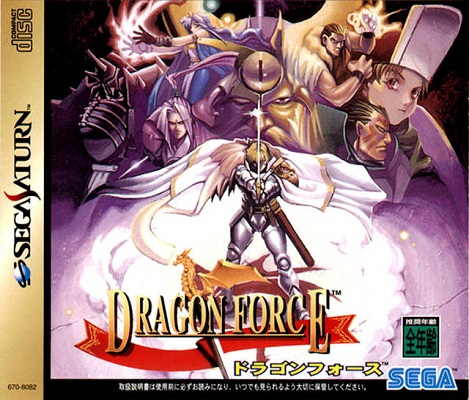Dragon Force (1996)
[ドラゴンフォース]

Publisher: Sega
Developer: J-Force, Sega
Director: Tomoyuki Ito
Platform: Sega Saturn
Overview:
The ambitions of Emperor Goldark of Fandaria plunge the continent of Legendra into the flames of war amid rumors of the Dark God Madruk's resurrection.
Gameplay:
You start out by picking one of the eight kingdoms. They are not simply interchangeable. The story does vary based on who your main character is. There are also the strategic concerns of geographical location and starting troop composition. It does make for good replay value and if you enjoy the game, it's worth your time to go through all eight scenarios.
The game is divided into two phases: the action phase and the administrative phase. The action phase takes place over the course of an in-game week and this is where you navigate the map, battle your rivals and so on. In the administrative phase at the end of the week, you can issue awards to your generals (to increase the number of troops they command), manage items, talk to your generals, try to flip prisoners, search for items and new recruits, fortify your castles, and save your progress. The administrative phase is also where story progress occurs.
Combat works as follows: You have a number of generals that command up to 100 troops of a given type. There are ten troop types that have affinities much like Pokemon. For instance, Soldiers get run down by Horsemen, who can be beaten by Monks who in turn get cut to ribbons by Soldiers. It doesn't always follow a neat rock-paper-scissors formula, but you pick it up fairly quickly. Your general can support his or her troops with special attacks limited by their MP and can also fend off enemy troops if needs be. When both sides' troops are depleted, the generals can duel, but this can be risky. A defeated general may be wounded and taken out of action for a couple weeks, captured or killed. Just as you can flip captured generals, the enemy can do the same, but the ease of flipping generals is based on their loyalty, so you won't be turning any of a nations core generals but neither will your rivals.
The goal is to find all eight of the Star Dragon Warriors. No points for guessing who these eight heroes are. While some nations will peacefully ally with you, most have to be taken down by force. You also have a rival faction within your own country that you have to deal with before you start venturing beyond your borders. There are dozens of castles to secure across the map and each castle can hold up to ten generals. You can replenish troops and deposit prisoners (so they don't get taken if you're defeated). The number of a castle's reserves depends on the castle's level and you can raise that either by fortifying it during the admin phase or just by holding on to it for a while without suffering any attacks. (Castle level drops each time it's attacked, by the way, so flashpoints are almost perpetually stuck in the single digits, making them all the harder to defend as you don't have reserves to replenish your forces.)
The game is at its most fun during the second act, when all eight nations are very aggressively going at it and there's a lot going on. Once you've conquered the map, though, progress stalls as you play out the remaining story beats (which includes long trips over much of the continent that can take multiple weeks). I suppose you can keep progress steadier by trying to trigger the story beats as you're conquering, but if you don't know beforehand what those triggers are, you're going to be lost until you get a hint during the admin phase. If the second act wasn't so much fun, the grind of the third would have a stronger negative impact.
Story/Characters:
The core story is fairly standard but executed well enough. There honestly isn't much time devoted to character development, but if you combine the experience of all eight campaigns, you get a fairly well-rounded look at our eight leads and a fair portion of the supporting cast. It's nowhere near as in-depth as many RPGs, but it does give flavor and context to the scenario.
Graphics:
Even for the time, the graphics don't particularly stand out, but they do their job and you can't complain much, though I could understand if you wanted more unique sprites for the generals. (Other than the main eight heroes, only a few of their generals get unique battle sprites and most of the incidental generals don't even get unique portraits.) The character designs are pretty good and we get some nice static cutscene panels.
Music/Sound:
The music is pretty good, mostly par for course for JRPGs of that era, but none of the tracks fall short of doing their job. Sound effects are adequate as well. No voice acting outside the animated opening and ending cutscenes, though.
Conclusion:
This is an immensely fun game and rightly heralded as one of the gems of the Saturn. If you like a good Risk-style game, then this is definitely worth playing.
Rating:
Own It
Special Note: There was a PS2 rerelease of this game in 2005 and this is actually the first version I played. The main differences in this version are updated character portraits and cutscenes (though you can toggle it to the original Saturn graphics) and voice acting, as well as an additional sidequest. You may find this one easier to come by, but it's worth noting that unlike the Saturn version that got an NA release, the PS2 version is Japan only.
